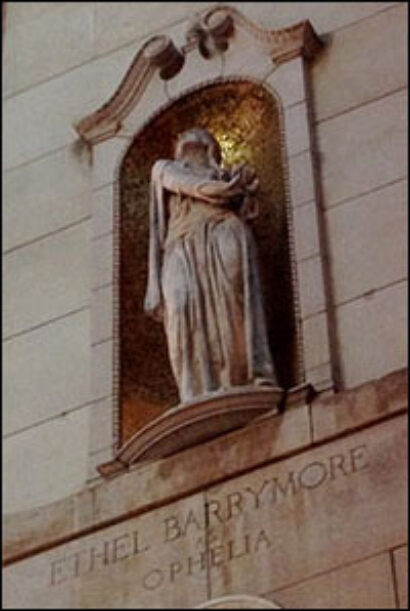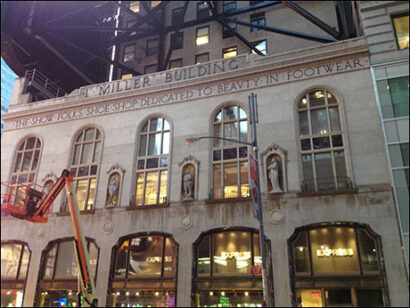
If you looked up at the second story of the building, on the 46th Street side, and squinted, you could discern four marble statues, old and dirty, nestled within a quartet of alcoves cut into the facade. The in-the-know understood that these were (from left to right): Ethel Barrymore as Ophelia in Hamlet; Marilyn Miller as Sunny in the 1925 hit musical of the same name; screen actress Mary Pickford as Little Lord Fauntleroy; and opera star Rosa Ponselle, in her most famous role, as Norma in Bellini's opera.
Certainly the owners of the TGI Friday's chain hadn't put the four female artists up there for the public to admire. That had been the work of the building's original owner Israel Miller, who was also the proprietor of the once-famous shoe store that occupied it from the 1920s until it closed in the 1970s; the statues were unveiled in 1929. Miller catered to the theatre crowd; his tongue-twisting slogan — still seen on the cornice — was "The Show Folks Shoe Shop Dedicated to Beauty in Footwear."
After Miller closed, the store — much like the rest of Times Square — fell into disrepair. The statues became covered with soot and grime. When TGI Friday's moved in, the figures were all but obscured by the eatery's huge, red-and-white signage. (The "Ethel" part of Barrymore's name was completely blocked.) Since the exterior of the building was landmarked in 1999, the statues couldn't be taken down. But neglect was doing its steady damage, year after year.
When the statues were taken down in 2012, many concerned locals feared they had been removed for good. Happily, the opposite turned out to be true. The figures, as well as the building's entire facade, were being restored. The refurbishment accompanies the unveiling of the building's latest tenant, an Express clothing store.
The work of restoring the artworks was assigned to Conservation Solutions Inc., a Maryland-based firm. Such tasks are fairly common for the firm, said Daniel Lane, CSI's vice-president of operations, and a conservator.
"The first thing we did was assess them prior to removal," he explained. "I actually got on a lift on the sidewalk there and assessed the condition of them. We found that two were so deteriorated that they had cracked in half." The cracks were at the knees of the Miller and Pickford figures, the two statues that have separate legs, as opposed to a flowing dress.
Before the statues were taken down, they were wrapped in plastic and then in plaster of Paris. Once at the Maryland studio, they were put on their sides, and each was pinned with stainless steel threaded rods to keep the figures intact. The statues were then consolidated to bring the crystals of the marble back together in tight formation and gently cleaned with water and brushes before being consolidated again. Finally, the figures were patched where patching was needed and their faces were remodeled.
To do the remodeling, CSI searched out original source materials. "We did some online research and we found the original drawings or photos that the statues were based on," said Lane, "with their costumes on."
The process took approximately four months. CSI was also responsible for restoring the niches the statues stood in, which were backed with gold-leaf-backed mosaic tiles. "It just needed a good cleaning," said Lane.
The I. Miller building is one of the oldest non-theatre structures facing Times Square, and the entire restoration now makes it one of the best preserved. The statues were originally executed by Alexander Calder, a noted artist of his day, whose works include the statue of Washington on the north side of the Washington Square Arch. (Today, he is best remembered as the father of mobile artist Alexander Calder.)
The four actresses were actually not Miller's own choices, but selected by the public, who were asked to choose one each from the fields of drama, comedy, opera and screen to honor. All four were remembered for performances that were then fresh in the public's memory: Barrymore played Ophelia in Hamlet in 1925 on Broadway, Marilyn Miller starred in Sunny in 1925, Pickford starred as Little Lord Faunleroy in a 1921 film and Rosa Ponselle portrayed Norma at the Metropolitan Opera in 1927.










